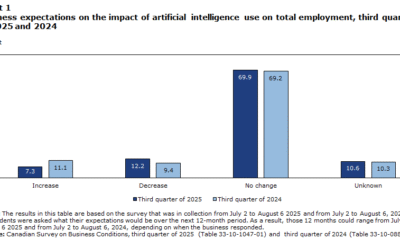Business
Tallying the True Costs of AI

A blank rectangle of a building sits next to a highway, facing an endless Wyoming prairie. It’s painted the greenish-grayish-brown that Disneyland imagineers use on stuff they don’t want people to notice. But the nine semitrailer-size green boxes nestling like nursing puppies into the building’s long sides are a giveaway. They’re giant heat exchangers meant to chill the stacks of black, pizza-box-shaped computers inside, squeezing electrons through silicon to make everything from streaming video to cryptocurrency.
This data center is one of several in Cheyenne. These buzzing hives of circuitry run the modern digital economy — and manage the unprecedented quantities of data and computation necessary for artificial intelligence.
Tech companies are racing to dominate a speculative future built on AI. Together, Amazon, Microsoft, Meta, and Google’s parent, Alphabet, have said they’ll spend at least $320 billion this year alone on facilities and equipment, overwhelmingly for AI.
Over several months, a team of Business Insider reporters and editors has delved deep into this nationwide infrastructure project. To create a comprehensive national list of data centers, we looked at the mass of permits to build these facilities. We learned how much water and electricity these places use, or are expected to, and the consequences for people’s everyday lives.
Business Insider identified 1,240 data centers in America already built or approved for construction at the end of last year — the most comprehensive tally to date. That’s nearly four times the number in 2010. Hundreds of those are the “hyperscalers” spinning up largely to power AI, the physical instantiation of a vast bet on a multitrillion-dollar reimagining of the global economy.
Tech companies envision a world where AI algorithms can replace doctors, make uncannily accurate disaster predictions, come up with universe-altering theories, act as personal assistants, teach our kids, or provide, ahem, companionship.
“You have to have the ability to create, right?” says Cortney Thompson, chief information officer and cofounder of Lunavi, which owns the Cheyenne data center. “Whether that’s on somebody else’s platform, whether it’s your own infrastructure, you have to have those resources available to create and innovate.”
That’s the possible upside. Business Insider’s analysis exposes the downsides — the costs we’re paying now.
We found that four out of 10 US data centers are (or are set to be) in places seriously short of water, and some of those facilities are permitted to guzzle millions of gallons a day.
Collectively, Business Insider estimates, US data centers could soon consume more electricity than what Poland, with a population of 36.6 million, used in 2023. Federal estimates expect that to as much as triple over the next three years.
The power plants that fuel that need will emit enough pollution to cause between $5.7 billion and $9.2 billion a year in public health costs, according to Business Insider estimates.
Taxpayers are subsidizing much of this boom, as local governments vie for projects they hope will refashion their towns into high-tech hubs with high-paying jobs. Business Insider found that many cities in places like central Ohio are giving sweeping tax breaks to tech giants that over years amount to $1 million or more for each long-term job.
Industry representatives say they’re working to reduce or offset the drawbacks — investing billions of dollars a year in green energy infrastructure, paying to restore water sources, and building more efficient tech. They point out that they’re responding to demand from consumers and corporations for a technology that could transform not just apps or devices but society itself. They believe the resource investment will be worthwhile.
Either way, the bills are coming due.
Secret costs
Virginia today is full of data centers — 329 of them, handling as much as a third of the planet’s internet traffic and consuming almost a fourth of the state’s electricity in 2023. There, and throughout the US, their construction is regulated by counties and regional utilities. Since regulating American land use is typically a local matter, data center construction usually gets brokered between the private-jet-flying, expensive-suit-wearing representatives of transnational technology oligopolies and, like, Dave from the local planning commission.
As an indirect consequence of that lopsided relationship, the amount of electricity and water those data centers use has been, effectively, secret — until now.
Greg Kahn for BI
Data centers draw power from the local utility grid. But they have to run 24/7, so if that power goes out, they rely on backup generators that burn diesel fuel or natural gas. To run them, data center owners must get permits, which require an accurate accounting of their emissions. That output maps to the data center’s power needs. By obtaining 1,240 permits from across the US, Business Insider calculated the potential near-term ecological footprint of every US data center owner, based on our estimate of how much electricity data centers typically use relative to the capacity of their backup systems. (See here for more on Business Insider’s methodology.)
Amazon tops the list. Business Insider’s estimate indicates that if it builds all the data centers it has planned, it would use 30 to 48 terawatt-hours a year. At the midpoint, that would be around the same amount of electricity the state of Nevada used in 2023.
An Amazon spokesperson said Business Insider’s methodology for estimating consumption “oversimplifies complex data center operations and is based on assumptions that do not account for important differences in how companies build and operate data centers.”
Google and Meta did not respond to Business Insider’s queries about data center power use estimates, and QTS declined to comment. A Microsoft spokesperson acknowledged that its data centers “do not always run at 100% of their installed capacity.”
The federal government estimates that demand for electricity will rise more this decade than it has since the 1980s; some calculations say data centers account for as much as 44% of that growth. Meeting that new demand will mean keeping older, dirtier generation capacity online — climate crisis and carbon commitments be damned.
Water is the most effective way to cool down the hotter, more closely packed graphics processing units that AI relies on. And that water often has to be fresh. Data centers are finicky drinkers.
In 2018, before the AI boom, US data centers consumed 34 billion gallons a year — just about what the state of California uses every day. Just seven years later, the US has doubled its data center capacity.
Now, here is where you’d expect a story like this to tell you how much water any data center of a given size uses. That’s almost impossible. Just half of all data center operators track their water use, and it’s wildly variable depending on size and technology.
Greg Kahn for BI
Thanks to the air permits Business Insider examined, we can at least tell you where those data centers are. That’s important because, given their needs, you might think that companies would site them near ready supplies of fresh water. They often don’t.
In fact, 40% of the data centers in the US are (or are set to be) in places marked by the World Resources Institute — a sustainability advocacy group — as having high or extremely high water scarcity. That includes multiple parts of the arid American Southwest — like Arizona’s Maricopa County, an “extremely water-stressed area” with 48 data centers.
Data center builders know all this, and they take water seriously. The biggest water users have pledged to do better — to be water-neutral in coming years, to pay other users to use less, or to fund water conservation projects as offsets. And they point out that just because they have permission to use millions of gallons of water a day doesn’t mean they will — and where water is scarce, they tend to favor air-cooling tech instead.
Of course, air cooling needs power. And however much they draw, data centers’ power needs are big enough that they tend to raise local electricity bills for everyone, Business Insider found — whether homes or Walmarts.
Their punishingly noisy cooling fans run all day and all night, making it tough for some who live near data centers. Every drop of water that goes to a data center could’ve gone to a home, or a different industrial or agriculture use — and outflows from the cooling systems risk polluting local waterways.
A future reckoning
Technological improvements could obviate this someday. More efficient heat exchangers could solve the cooling problem. A more flexible power grid or AI that uses far less energy might solve the power problem.
Jesse Rieser for BI
Though some utilities are bringing new fossil-fuel plants online, renewable solutions are emerging — a few miles from the data center in Cheyenne, a massive solar farm is rising alongside hundreds of already-spinning wind turbines.
We can marvel at new applications like real-time language translation or more accurate cancer diagnoses. We can scoff at the latest chatbot hallucination — or worry about policy or military decisions made not in the White House or the Pentagon but in data centers guided by algorithms few understand. All this happens while water aquifers drain and electricity bills climb.
A handful of transnational corporations are offering this proposition: They will usher in an age of technological wonder in return for the opportunity to make a tremendous amount of money. State after state is giving them more money, and reorienting entire regulatory structures, to let them do it. If the AI revolution delivers, perhaps the ledger eventually balances. If not, we’ll be left with the receipts for a future that never arrived.
Business
Spain’s digital business school ISDI & Microsoft bet on AI in executive MBAs •

Keep up to Date with Latin American VC, Startups News
At a time when artificial intelligence (AI) is redefining work, ISDI, Spain’s digital business school, and Microsoft have formed an alliance to incorporate the real-world use of generative AI into executive training.
According to Microsoft’s Workplace Trends Report, 50% of executives in countries like Spain believe that training their teams in the use of AI will be key in the next five years.
For this reason, ISDI says it is seeking to connect theory and practice in an academic environment that adapts to the challenges of digital transformation.
Microsoft, for its part, brings its technological expertise so that artificial intelligence becomes a tangible, competitive resource for MBA grads.
“We want to train complete professionals, capable of leading business transformation in a context marked by AI,” said Basola Vallés, Executive Director of ISDI, through a press release.
The business school has faculty and alumni from around the world, including Latin America, and has an international campus in Mexico.
Creating AI Agents
The module, titled Crea tu Agente IA (Create your AI Agent), unfolds over five milestones in the master’s degree: from agent activation in Microsoft’s Copilot Studio, to application in real projects, simulation of strategic scenarios and career development.
Upon completion, each participant will have a trained and operational AI agent ready to accompany the student beyond the classroom. This practical approach contrasts with theory-focused programs by integrating AI into the day-to-day work life.

With this initiative, the Executive MBA in Business and Technology (MIB) is positioned as the first Executive MBA in Spain to structurally integrate business, technology, artificial intelligence and human development, according to the university.
Paco Salcedo, president of Microsoft Spain, added: “Our technology is designed for students to turn AI into a real advantage for their organizations”.
The proposal is reinforced with a project linked to business challenges and with an employability component.
A study by LinkedIn and Microsoft reveals that professionals who mention AI in their profiles are 17% more likely to be considered in selection processes.
The impact of the program has already been recognized by several media, which places it amongst the most influential executive master’s programs in Spain.
MIB graduates record an average salary increase of 38% in the year after graduation and 70% job mobility, according to figures shared with Contxto that reflect how the combination of business, technology and now generative AI can transform a career path.
According to a report published by Intel and analyst firm IDC, just 14% of Latin American companies have adopted AI agents in their work processes, putting the region in need of adapting to today’s challenges.
This trend of MBA programs that prioritize the use of generative AI could help to motivate future business leaders in the region and will hopefully boost the adoption figures of this technology in the coming years.
Keep up to Date with Latin American VC, Startups News
Business
Innovative AI Solutions Transforming Business Operations and Customer Interactions

Fulcrum (www.fulcrumapp.com) field-focused process and data collection platform for geospatial field processes and data collection recently launched Audio FastFill, a voice-powered, multi-field AI data collection tool.
It integrates advanced AI within the platform to create a textual scribe for field teams, eliminating inefficiencies of manual entry, and allows users in the field to dictate forms naturally and produce richer more actionable data input, with the system understanding and accurately populating fields.
Fulcrum dynamically understands context to populate complex fields like picklists and conditional logic, eliminating inefficiencies of manual entry and simplifying workflow, helping ensure ease of use in demanding environments. It can also dissect one continuous audio file to place all of the information into the correct corresponding fields and input to fields that aren’t text, like numbers or drop-down lists.
Pricing: structure not actual cost, free demo, free trial.
AIPhone
AIPhone (www.aiphone.ai) is a cross language calling app utilizing AI translation. It translates phone calls in real time—speak in your language and the other party hears it in theirs instantly and vice versa. How it works: you invite anyone via a simple link—no extra app needed for them.
The app, which supports several dozen languages and dialects, is trained to both translate words and understand the context behind them. In addition, it also supports camera translation—snap a photo or select a saved image (e.g. a sign) and get instant translation. It also translates video and voice calls in WhatsApp and other apps.
Pricing: weekly, monthly, annual plans available with free trial package available through X, TikTok, and Facebook.
ServiceMonster
ServiceMonster management software (www.servicemonster.com, 888/901-3300, covered in September 2022 column) recently introduced the ServiceMonster Payments mobile app, which features capabilities that facilitate both immediate branded invoicing that can be sent by email or text and collection of payments via credit cards, debit cards, and ACH. Suitable for solo operators and multi-crew service businesses, it has the ability to automate reminders and follow-ups. You can store cards on file securely for repeat customers or recurring billing.
ServiceMonster Payments includes built-in surcharging, allowing you to legally pass along credit card processing fees to your customers where permitted by law. Surcharging is automatically configured during setup based on your location. Most credit card and debit card transactions are deposited into your bank account in as little as two business days. The solution Payments offers an integration with QuickBooks Online and QuickBooks Desktop. A demo is available.
Plannit
Plannit (www.plannit.io), covered in August 2021 column, recently added a smart call answering system designed to function as a virtual assistant, handling calls when team members are unavailable. The system, which is available 24/7 and has multi-language support, features intelligent call routing, utilizing advanced algorithms to direct calls to appropriate departments or personnel based on predefined criteria.
Users can customize menu options and the software, which can take messages, can be programmed to answer FAQs. It can also qualify and prioritize prospective customers by asking questions and recording their answers and saving them in the messaging center as audio files. The service requires a new phone number acquired by Plannit, but calls to existing business numbers can be redirected for message taking when needed.
Gorilla Desk
Update: Gorilla Desk (www.Gorilladesk.com), initially covered in January 2025 tech column, has several new AI Agents to its platform (both desktop and mobile app) which are designed to heighten proficiency of field service management and handle customer interactions across multiple channels, including SMS, Web Chat, VOIP phone, and client portals.
The new capabilities, available on the customer portal and by text message, enable customers to book services 24/7, with the solution streamlining and automating the entire process, from inquiry to booking and confirmation, as well as route planning and optimization.
How it works: you embed your AI agent options directly on your web site and, as desired, your customer initiates the process by making contact with your embedded company AI receptionist through one of those portals, facilitating making, logging, and finding all calls without jumping among apps; the Client Portal Agent enables customers to request new work securely and view previous documents anytime. Gorilla Desk will notify you via in-app and email alerts whenever a new work request is submitted.
There are two types of AI conversations: static and dynamic. Static conversations provide general Q&As with informational responses. Dynamic conversations involve the system taking actions, such as capturing new lead info or scheduling a pending booking. (Pricing: $1.00 per completed static conversation, $1.75 per completed dynamic conversation.)
Gorilla Desk also has four new agents in the works: Kong AI (Supreme Intelligence), acting as the central intelligence, which will provide advanced analytics and generate custom reports; Mantis AI (Ops & Admin), which will automate the role of administrator and help run day-to-day operational workflows flawlessly; Atrax AI, which will help you deploy your website, aiding in page generation and optimization; Lotus AI (Customer Sentiment), which focuses on delivering analysis of customer standpoint so you know what conversations need real human attention; and SMS & Customer Portal Agents, enabling 24/7 handling of incoming customer SMS messages their conversations with your AI.
Business
Your browser is not supported
democratandchronicle.com wants to ensure the best experience for all of our readers, so we built our site to take advantage of the latest technology, making it faster and easier to use.
Unfortunately, your browser is not supported. Please download one of these browsers for the best experience on democratandchronicle.com
-

 Business2 weeks ago
Business2 weeks agoThe Guardian view on Trump and the Fed: independence is no substitute for accountability | Editorial
-
Tools & Platforms1 month ago
Building Trust in Military AI Starts with Opening the Black Box – War on the Rocks
-

 Ethics & Policy2 months ago
Ethics & Policy2 months agoSDAIA Supports Saudi Arabia’s Leadership in Shaping Global AI Ethics, Policy, and Research – وكالة الأنباء السعودية
-

 Events & Conferences4 months ago
Events & Conferences4 months agoJourney to 1000 models: Scaling Instagram’s recommendation system
-

 Jobs & Careers2 months ago
Jobs & Careers2 months agoMumbai-based Perplexity Alternative Has 60k+ Users Without Funding
-

 Podcasts & Talks2 months ago
Podcasts & Talks2 months agoHappy 4th of July! 🎆 Made with Veo 3 in Gemini
-

 Education2 months ago
Education2 months agoMacron says UK and France have duty to tackle illegal migration ‘with humanity, solidarity and firmness’ – UK politics live | Politics
-

 Education2 months ago
Education2 months agoVEX Robotics launches AI-powered classroom robotics system
-

 Funding & Business2 months ago
Funding & Business2 months agoKayak and Expedia race to build AI travel agents that turn social posts into itineraries
-

 Podcasts & Talks2 months ago
Podcasts & Talks2 months agoOpenAI 🤝 @teamganassi






















